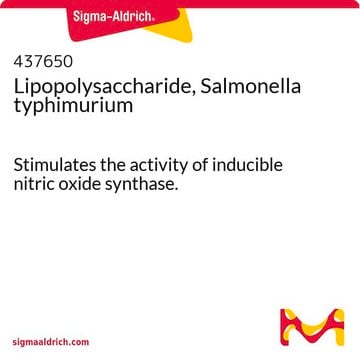L6143
Lipopolysaccharides from Salmonella enterica serotype typhimurium
suitable for cell culture, BioXtra, γ-irradiated
Synonym(s):
LPS
About This Item
Recommended Products
biological source
Salmonella enterica (serotype typhimurium)
Quality Level
sterility
γ-irradiated
product line
BioXtra
form
lyophilized powder
purified by
gel-filtration chromatography
technique(s)
cell culture | mammalian: suitable
impurities
<1% Protein (Lowry)
storage temp.
2-8°C
Looking for similar products? Visit Product Comparison Guide
Application
- in mice to elicit the secretion of pro-inflammatory cytokines
- to induce cytokine production in monocytes
- to elicit the activation of NF-κB pathway in mouse dendritic cells.
- to induce inflammatory response in human colon adenocarcinoma Caco-2 cells
- for stimulation of the catfish peripheral blood leukocytes (PBLs) to study estrogen receptor mRNA expression
Biochem/physiol Actions
Reconstitution
Other Notes
related product
Signal Word
Warning
Hazard Statements
Precautionary Statements
Hazard Classifications
Acute Tox. 4 Dermal - Acute Tox. 4 Inhalation - Acute Tox. 4 Oral
Storage Class Code
11 - Combustible Solids
WGK
WGK 3
Flash Point(F)
Not applicable
Flash Point(C)
Not applicable
Personal Protective Equipment
Certificates of Analysis (COA)
Search for Certificates of Analysis (COA) by entering the products Lot/Batch Number. Lot and Batch Numbers can be found on a product’s label following the words ‘Lot’ or ‘Batch’.
Already Own This Product?
Find documentation for the products that you have recently purchased in the Document Library.
Customers Also Viewed
Articles
Explore the structure, function, and diverse applications of Lipopolysaccharides. Discover their role in bacteria, serological specificity, and research potential.
Explore the structure, function, and diverse applications of Lipopolysaccharides. Discover their role in bacteria, serological specificity, and research potential.
Explore the structure, function, and diverse applications of Lipopolysaccharides. Discover their role in bacteria, serological specificity, and research potential.
Explore the structure, function, and diverse applications of Lipopolysaccharides. Discover their role in bacteria, serological specificity, and research potential.
Our team of scientists has experience in all areas of research including Life Science, Material Science, Chemical Synthesis, Chromatography, Analytical and many others.
Contact Technical Service





